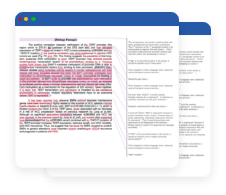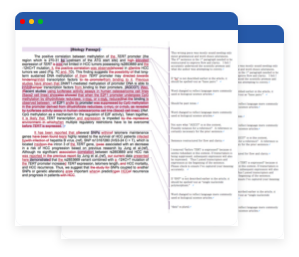如何使用逗號(,)
逗號是英文結構的關鍵組成要素。它可以用來劃分句子的不同部分。適當地使用逗號能使文字清晰易讀,預防歧義的發生,並創造文句的自然流暢。
可惜的是,許多作者忽略了逗號的正確用法。這一篇簡單易解的指南,我們將為您說明逗號的使用時機與方法。
目錄
- 1.用逗號連接子句
- 2.主詞、動詞與受詞的使用規則
- 3.限定子句與非限定子句
- 4.引導元素後面的逗號
- 5.牛津逗號
- 6.E.g. 與 I.e.
逗號的使用時機
| 錯誤 | 正確 | |
|---|---|---|
| 當用對等連接詞連接兩個獨立子句 |
The apple is red the orange is green. |
The apple is red, and the orange is green. |
| 分隔非限定子句 |
The apple which is red is for the teacher. |
The apple, which is red, is for the teacher. |
| 分開引導詞或片語 |
In the afternoon we are going to pick apples. |
In the afternoon, we are going to pick apples. |
| 列出多個項目 |
He likes apples oranges and pears. |
He likes apples, oranges, and pears. |
用逗號連接子句
連接子句是逗號的主要功能之一。逗號不僅能使句子更自然流暢,也能釐清句子被修飾了哪個部分。
獨立子句 vs. 從屬子句
獨立子句包含一對主詞和動詞,並表達一個完整的想法。換言之,獨立子句是一個單獨運作的完整句子。參閱以下的範例。
- The apple is red.
- Apples grow on trees.
- Susan has picked an apple.
另一方面,從屬子句雖然包含一對主詞和動詞,但並不能表達一個完整的想法。從屬子句不是一個完整的句子。
- when it is ripe
- although not all fruits grow on trees
- because it looked delicious
從屬標記詞(dependent marker word)把獨立子句變成從屬子句。
- It is ripe. → when it is ripe
- Not all fruits grow on trees. → although not all fruits grow on trees
- It looked delicious. → because it looked delicious
常用的從屬標記詞 : because, despite, if, before, although, though, before, after, since, as, unless, until, when, whenever, whether, while
連寫句(run-on sentences)與逗號拼接(comma splice)
連寫句(run-on sentences)是兩個沒有正確分開或連接的獨立子句。分開或連接兩個獨 立子句有三種不同的方式。
-
用一個句號
由於獨立子句是完整的句子,因此你可以用一個句號分開兩個獨立子句。
- 子句 1
- The apple is red.
- 子句 2
- It is for the teacher.
- 合併
- The apple is red. It is for the teacher.
-
用分號(或冒號——決定於子句的關聯方式)
分號可以用來連接兩個密切相關的獨立子句
- 子句 1
- Susan likes reading.
- 子句 2
- She has been reading since she was two.
- 合併
- Susan likes reading; she has been reading since she was two.
冒號的用法也類似,但兩個子句的內容要緊密相關,而且第二個子句要定義第一 個子句。
- 子句 1
- The orange was a favorite of Portuguese sailors.
- 子句 2
- The fruit is high in vitamin C, which is effective for preventing scurvy.
- 合併
- The orange was a favorite of Portuguese sailors: the fruit is high in vitamin C, which is effective for preventing scurvy.
-
用一個與連接詞合併的逗號
逗號可以和連接詞合併使用。使用的重點是選擇一個最適合上下文的連接詞。
常用的連接詞: and, or, but, so, yet, for
- 子句 1
- Apples grow on trees.
- 子句 2
- Not all fruits grow on trees.
- 合併
- Apples grow on trees, but not all fruits grow on trees.
連接兩個獨立子句有三種錯誤的方式:
-
不使用標點符號
連接兩個獨立子句最明顯的不正確方法,就是不用標點符號或連接詞就把它們放在一起。
- 錯誤
- Apples grow on trees not all fruits grow on trees.
-
只用一個逗號
逗號本身不足以正確地連接兩個獨立子句。這種錯誤稱為逗號拼接(comma splice)。
- 錯誤
- Apples grow on trees, not all fruits grow on trees.
-
只用一個連接詞
單獨使用一個連接詞,不足以正確地連接兩個獨立子句。
- 錯誤
- Apples grow on trees but not all fruits grow on trees.
合併獨立子句也可以用其他的標點符號,例如:句號或分號,或使用一個跟隨著連接詞的逗號。
- 正確
- Apples grow on trees. Not all fruits grow on trees.
- 正確
- Apples grow on trees, but not all fruits grow on trees.
主詞、動詞與受詞的逗號使用規則
逗號不能隨便插入句子的任何一個位置。最值得注意的是,逗號不應該(1)分開主詞和動詞,或(2)分開動詞和受詞。
注意:不應該把主詞和動詞分開
許多作者認為逗號應該放在說話者語氣停頓的地方。在英語的口語中,人們偶爾會在主詞和動詞之間停頓。然而,用英語寫作時,在主詞和動詞之間加逗號會打斷句子的自然流暢。
- 錯誤
- Susan’s roommate Rosa, planted an apple tree.
- 正確
- Susan’s roommate Rosa planted an apple tree.
注意:不應該把動詞和受詞分開
逗號不應該把及物動詞(transitive verb)和直接受詞(direct object)分開。就像上面的情況一樣,這是另一個很難憑著直覺發現的錯誤。把動詞和受詞分開會影響句子的可讀性,並使句子顯得不自然。
- 錯誤
- Susan said, her roommate planted a tree.
- 正確
- Susan said her roommate planted a tree.
限定子句和非限定子句
使用逗號的關鍵在於了解子句類型的差別。最重要的差別是獨立子句和從屬子句。然而,區別限定子句和非限子句也很重要。
限定子句 vs. 非限定子句 —— 有什麼差別?
限定子句與非限定子句的關鍵差別,與資訊的必要性有關。限定子句提供與名詞或名詞片語有關的首要資訊。另一方面,非限定子句則提供與名詞或名詞片語有關的補充資訊。
- 例句
-
The essay that Jane wrote is five pages long.
“that Jane wrote” 是一個限定子句,因為沒有它,我們就不清楚有五頁長的散文是哪一篇。珍寫了這篇散文的事實,是首要的資訊。
- 例句
-
Jane’s essay, which is five pages long, got an A.
“which is five pages long” 是一個非限定子句。這句話的主要重點是珍寫的散文得到了 A。那一篇散文的長度是補充資訊。
注意:不應該使用逗號隔開限定子句
限定子句不應該被逗號分開。
- (a)
- The girl who sits in the front asks a lot of questions.
- (b)
- The girl, who sits in the front, asks a lot of questions.
哪一個句子是正確的:(a)或(b)?首先,必需辨識 “who sits in the front” 是限定子句還是非限定子句。沒有 “who sits in the front” 這個子句,我們就不清楚問了很多問題的是哪一個女孩。因此, “who sits in the front” 是一個限定子句。正確的句子是(a)。
注意:使用逗號隔開非限定子句
非限定子句應該用逗號分開。
- (a)
- My friend Amy who sits in the front asks a lot of questions.
- (b)
- My friend Amy, who sits in the front, asks a lot of questions.
哪一個句子是正確的:(a)或(b)?同樣地,我們需要先辨識 “who sits in the front” 是限定子句或非限定子句。主要的重點是艾米問了很多問題。她坐在前面的事實是補充資訊。因此, “who sits in the front” 是一個非限定子句。正確的句子是(b)。
引導元素後面的逗號
每一個引導元素後面都應該跟著一個逗號。這有助於釐清引導元素結束與句子主要部分開始的地方。
- (a)
- After eating lunch with his friends, Peter went to the library.
- (b)
- After eating lunch with his friends Peter went to the library.
比較(a)與(b),顯然(a)的可讀性比較高。這是因為把引導元素——“after eating lunch with his friends”——後面的逗號拿掉,我們就難以感知主詞「彼得」的位置。
牛津逗號(Oxford Comma)
一般來說,牛津逗號(Oxford comma)或系列逗號(serial comma)是選擇性的(但在同一篇文章裡應否使用牛津逗號要前後一致)。然而,這是美式英語的標準用法,也是某些寫作風格強制性的準則。此外,為了避免歧義,某些情況是必須使用牛津逗號的。
- 例句
- Lana wrote letters to her parents, Leia and Michael.
這個句子可做兩種詮釋:(1)Leia和Michael是她父母的名字,或(2)Lana寫信給她的父母和另外兩個叫Leia和Michael的人。在Leia後面加一個逗號,可以清楚地表示Leia和Michael是另外兩個人,而不是Lana父母的名字。
e.g. 與 i.e
在 e.g. 和 i.e. 後面使用逗號的規則,因寫作風格的不同而異。然而,標準的美式英語, 始終都要在 e.g. 和 i.e. 後面加一個逗號。
- 錯誤
- There are many tropical fruits, e.g. mangos, coconuts, and bananas.
- 正確
- There are many tropical fruits, e.g., mangos, coconuts, and bananas.











